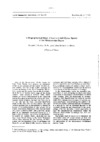Identificador persistente para citar o vincular este elemento:
https://accedacris.ulpgc.es/jspui/handle/10553/76926
| Campo DC | Valor | idioma |
|---|---|---|
| dc.contributor.author | Haroun, Ricardo J. | en_US |
| dc.contributor.author | Prud'Homme van Reine, Willem F. | en_US |
| dc.date.accessioned | 2020-12-22T15:32:50Z | - |
| dc.date.available | 2020-12-22T15:32:50Z | - |
| dc.date.issued | 1993 | en_US |
| dc.identifier.uri | https://accedacris.ulpgc.es/handle/10553/76926 | - |
| dc.description.abstract | Most of the Macaronesian islands, except the Cape Verde Islands. were included by FELDMANN (1946) in the Lusitano-African region. In more recent studies, VAN DEN HOEK (]984) included the Azorean archipelago in the Warm Temperate NE Atlantic region and the Azores flora is also incorporated in the list of benthic marine algae of the North Atlantic Ocean (SOUTH & TITTLEY 1986). PRUD' HOMME VAN REINE (1988) assigned to the Azores an intermediary position between the subtropical Macaronesian islands (Madeira, Salvages and Canaries) on the one side and the warm temperate Eurafrican coasts on the other side. On the contrary, the Cape Verdean seaweed flora is characterized as tropical on account of the predominance of alga! species with a tropical distribution (FELDMANN 1946; VAN DEN HoEK 1975, 1984). LAWSON & JOHN (1987), however, on the basis of an ordination (reciprocal averaging) oí a large number of tropical and subtropical seaweed floras around the Atlantic Ocean, concluded that the Cape Verde Islands belong to the Warm Temperate African flora, including also the Canarian, the Mauritanian and the Senegalese floras. PRUD'HOMME VAN REINE & V DEN HOEK {1988), however, found out a separate and individual position, with a distinct E America imprínt for the Cape Verdean seaweed flora. Thus, additional studies are needed to better understanding the biogeographícal position of the seaweed floras present in the Macaronesian archipelagos. In the Macaronesian region the assembled seaweed flora of each archipelago is clearly dominated by members of Rhodophyta (PRUD'HoMME VAN REINE 1988; LEVRING 1974; GIL-RODRÍGUEZ & APONSOCARIULLO 1980; PRUD'HOMME VAN REINE & VAN DEN HOEK 1988). Among those red algae, the genera Laurencia and Hypnea have several species, mainly in intertidal and shallow sublittoral habitats. Nevertheless, it is possible to find an latitudinal gradient in the respective florula size and compositíon for each archipelago. This íact provides a sound opportunity to study the biogeographical relationships within the different Macaronesian archipelagos and with surrounding areas. The present study is carried out to determine the taxonomical status of several species of these two genera and to further contribute to the biogeographical relationships of the Macaronesian archipelagos seaweed floras. | en_US |
| dc.language | eng | en_US |
| dc.relation.ispartof | CFS Courier Forschungsinstitut Senckenberg | en_US |
| dc.source | Courier Forschungsinstitut Senckenberg, 1993, v. 159, p. 119-125 | en_US |
| dc.subject | 251004 Botánica marina | en_US |
| dc.subject.other | Laurencia | en_US |
| dc.subject.other | Hypnea | en_US |
| dc.subject.other | Macaronesia | en_US |
| dc.title | A biogeographical study of Laurencia and Hypnea species of the Macaronesian region | en_US |
| dc.type | info:eu-repo/semantics/article | - |
| dc.type | Article | - |
| dc.description.lastpage | 125 | en_US |
| dc.description.firstpage | 119 | en_US |
| dc.relation.volume | 159 | en_US |
| dc.investigacion | Ciencias | en_US |
| dc.type2 | Artículo | - |
| dc.description.numberofpages | 7 | en_US |
| dc.identifier.ulpgc | Sí | en_US |
| dc.contributor.buulpgc | BU-BAS | en_US |
| item.grantfulltext | open | - |
| item.fulltext | Con texto completo | - |
| crisitem.author.dept | GIR ECOAQUA: Biodiversidad y Conservación | - |
| crisitem.author.dept | IU de Investigación en Acuicultura Sostenible y Ec | - |
| crisitem.author.dept | Departamento de Biología | - |
| crisitem.author.orcid | 0000-0003-1348-692X | - |
| crisitem.author.parentorg | IU de Investigación en Acuicultura Sostenible y Ec | - |
| crisitem.author.fullName | Haroun Tabraue, Ricardo Jesús | - |
| Colección: | Artículos | |
Visitas
141
actualizado el 20-jul-2024
Descargas
103
actualizado el 20-jul-2024
Google ScholarTM
Verifica
Comparte
Exporta metadatos
Los elementos en ULPGC accedaCRIS están protegidos por derechos de autor con todos los derechos reservados, a menos que se indique lo contrario.
